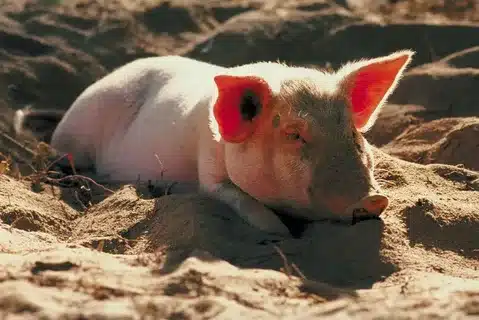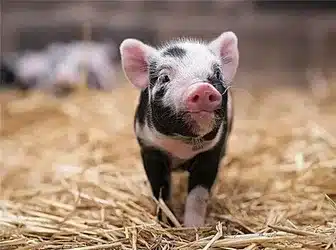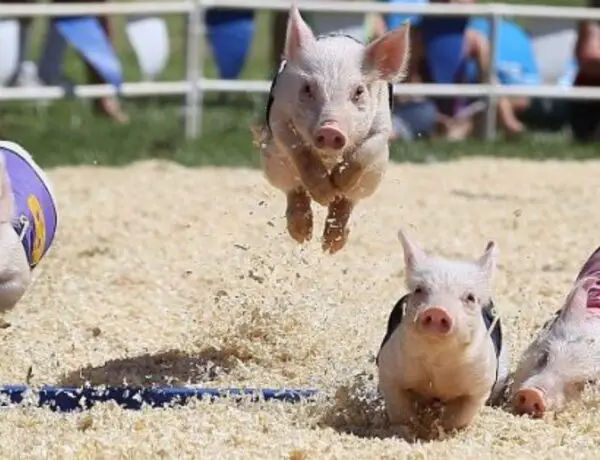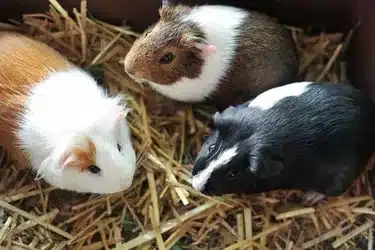Introduction
How To Raise A Pig: Raising a pig can be an engaging and fulfilling endeavor, whether you’re considering it as a hobby or part of a small-scale farming operation. Pigs are intelligent, sociable animals that require attention and care throughout their lives. This introduction will provide you with some essential information on how to raise a pig successfully.
First, it’s crucial to select the right pig breed for your specific goals, considering factors like size, temperament, and purpose. Pigs need a sturdy and well-ventilated shelter to protect them from the elements and predators. Maintaining cleanliness and providing a balanced diet are key to their health and growth. Regular health check-ups, hygiene, and sanitation practices are vital to prevent diseases.
Pigs also require adequate space for exercise and social interaction, as they are social animals that thrive with companionship. Monitoring their growth and understanding local regulations and zoning laws are also essential aspects of pig farming. Finally, consider adopting sustainable and ethical practices in your pig farming operation to minimize environmental impact and ensure the humane treatment of your animals. Raising pigs can be a rewarding experience when done with dedication and proper care.

Are pigs easy to raise?
I really think pigs are one of the easiest animals to raise on a homestead. They mature quite a bit faster than a beef cow and render way more meat (and lard) than a chicken or rabbit (and frankly pulled pork, fresh bacon, lard rendered at home, and salt-cured hams are just amazing!!!).
Pigs: The Lowdown
Raising pigs can be a rewarding venture, but before diving into the world of swine, it’s important to consider their overall ease of care.
Initial Effort: Pigs might not be the most straightforward choice for beginners. They require a substantial initial effort in terms of housing and setup. You’ll need a sturdy enclosure, proper fencing, and access to clean water and food.
Diet Matters: Pigs are voracious eaters and require a balanced diet. You’ll need to provide a mix of grains, vegetables, and protein sources, and monitor their intake to avoid overfeeding.
Space and Environment: Pigs need ample space to roam and root around. Adequate shelter from extreme weather conditions is essential, as is maintaining a clean and sanitary living environment.
Health Management: Regular health check-ups are necessary to monitor their well-being and prevent diseases. Pigs can be susceptible to various ailments, so a good working relationship with a veterinarian is crucial.
Social Animals: Pigs are social creatures and thrive in the company of other pigs. Loneliness can lead to stress and behavioral issues, so consider raising at least two pigs together.
Time and Commitment: Raising pigs requires dedication and time. Daily chores, feeding, and cleaning can be demanding, especially during harsh weather conditions.
How do you raise pigs naturally?
Some folks will grow a field of corn, grain, beans, or turnips and let the pigs harvest them. Make sure that there is plenty of fresh water (warm in the winter) available for pigs at all times. Water is necessary for proper digestion and pigs eating dry feed rations particularly require plenty of water.
Raising Pigs Naturally: A Sustainable Approach
Raising pigs naturally, often referred to as “pasture-raised” or “free-range” pig farming, is a sustainable and humane way to provide for these animals while producing high-quality pork. Here’s how you can raise pigs naturally, with a focus on their well-being and environmental impact.
Adequate Space and Foraging: Give your pigs ample space to roam and forage. Pasture-based systems allow pigs to express their natural behaviors, rooting in the soil, and foraging for food like grass, roots, and insects.
Rotational Grazing: Implement rotational grazing to prevent overgrazing and soil degradation. Move pigs to different areas periodically to allow vegetation to regenerate naturally.
Natural Diet: Encourage a diverse and natural diet. In addition to foraging, provide supplementary feed like fruits, vegetables, and grains, but avoid excessive commercial feed. Pigs can thrive on a diet rich in fiber and nutrients from the land.
Shelter and Protection: Offer shelter for pigs to seek refuge from harsh weather conditions and predators. A simple, well-insulated structure is usually sufficient.
Health Management: Prioritize preventive health care. Maintain a clean living environment, ensure access to clean water, and monitor their health closely. Natural remedies and holistic approaches can be used when necessary.
Minimal Stress: Minimize stress during handling and transportation. Gentle, low-stress management practices lead to healthier and more content pigs.
Ethical Considerations: Treat pigs with respect and compassion throughout their lives. Natural pig farming emphasizes humane handling and slaughter practices.
Sustainable Practices: Employ sustainable farming methods to minimize the environmental impact. Proper waste management, crop rotation, and integration with other livestock can contribute to a healthier ecosystem.
What are the disadvantages of pigs?
Con: Pigs eat a lot, which means that pigs poop a lot. While they are much cleaner than we are often led to believe, their pens can really stink on a hot day! They generally designate a corner of their pen as the restroom, which seems rather civilized, but is still quite smelly when you are downwind.
Disadvantages of Raising Pigs
While pigs can be rewarding animals to raise, there are several disadvantages to consider before embarking on pig farming. These challenges range from their care requirements to potential environmental and health concerns.
Odor and Waste Management: Pigs produce a significant amount of waste, and their pens can become odorous if not properly managed. Effective waste management systems are necessary to mitigate this issue.
Space Requirements: Pigs require ample space to move and root around. Larger breeds need more space, which can be a limitation for those with limited land resources.
Dietary Needs: Pigs have specific dietary requirements, and their voracious appetite means higher feed costs. Balancing their diet with a mix of grains, vegetables, and protein sources can be challenging.
Disease Susceptibility: Pigs are susceptible to various diseases, including respiratory and digestive issues. Regular health checks and vaccinations are necessary to prevent outbreaks.
Aggressiveness: Pigs can exhibit aggressive behavior, especially during feeding times. This can pose safety concerns for handlers and other animals.
Predators: Pigs are vulnerable to predators such as coyotes and wolves. Ensuring their safety through secure fencing and shelter is essential.
Zoning Regulations: Local zoning laws and regulations may restrict or prohibit pig farming in certain areas due to environmental concerns or proximity to residential areas.
Time and Effort: Raising pigs requires consistent time and effort. Daily feeding, cleaning, and health checks are necessary tasks, making pig farming a commitment.
Environmental Impact: Large-scale pig farming can have a significant environmental impact due to waste runoff and water pollution. Sustainable practices are essential to mitigate these concerns.
Ethical Considerations: Some individuals may have ethical concerns about raising pigs for meat, particularly in relation to animal welfare and slaughter practices.
How much pig feed per day?
The average amount that your pig will grow each day is between 1.7 and 2.0 pounds. 2. The average amount of feed your pig will consume each day is between 5 and 7 pounds per day.
Determining Daily Pig Feed Amount
Feeding your pigs the right amount of food is crucial for their health, growth, and cost-effective farming. The daily pig feed amount varies based on factors like age, breed, weight, and purpose (e.g., meat production or pets). Here’s a general guideline to help you determine how much pig feed to provide each day.
Age and Growth Stage: Piglets (0-6 weeks): Piglets should be fed several times a day, starting with small amounts and gradually increasing. Aim for 1/4 to 1/2 pound (4 to 8 ounces) per feeding.
Growing Pigs (6-20 weeks): Growing pigs require more feed as they develop. On average, they can consume 2-4 pounds of feed per day.
Adult Pigs (20 weeks and older): Adult pigs’ feed intake depends on their weight and purpose. A mature pig can eat anywhere from 4 to 8 pounds of feed daily. Breeding sows may require more, especially during gestation and lactation.
Breed and Size: Different pig breeds have varying appetites and growth rates. Larger breeds tend to eat more than smaller ones.
Purpose and Activity Level: Pigs raised for meat production generally eat more than those kept as pets. Pigs with higher activity levels, such as those in a pasture-based system, may also require more feed.
Quality of Feed: The nutritional content of the feed affects the amount required. High-quality, balanced pig feed may require smaller quantities compared to lower-quality feed.
Monitoring and Adjusting: It’s essential to monitor your pigs’ weight and body condition regularly. Adjust their feed amounts accordingly to ensure they are neither underfed nor overweight.
Can pigs survive alone?
We know there are a lot of opinions out there; however, the research shows that pigs don’t do as well as single pigs. Potbellied pigs are intelligent and complex creatures and have social hierarchies and herd dynamics. To be truly happy, they need the companionship of another pig(s).
Pigs and Solitude: Can They Survive Alone
Pigs, inherently social animals, thrive on interaction and companionship. Survival for a pig living in isolation can be challenging and detrimental to their overall well-being. Here’s a closer look at why pigs are better off not living alone:
Social Nature: Pigs are highly social animals that naturally form strong bonds with other pigs. In the wild, they live in groups or sounders, relying on the presence of their peers for safety and comfort.
Emotional Needs: Pigs can experience emotions like loneliness and stress when kept alone. These feelings can lead to behavioral issues, decreased appetite, and overall poor health.
Mental Stimulation: Pigs are intelligent creatures that need mental stimulation. Interaction with other pigs and the opportunity to engage in natural behaviors like rooting and exploring are essential for their mental well-being.
Aggression and Anxiety: Isolated pigs may become aggressive or anxious, potentially causing harm to themselves or their environment. Lack of social interaction can lead to destructive behavior.
Physical Health: Loneliness can affect a pig’s physical health as well. They may become lethargic, with a weakened immune system, making them more susceptible to diseases.
Lifelong Companions: Pigs often form lifelong bonds with their fellow pigs. Separating them can cause emotional distress, akin to separating humans from their loved ones.
Can pigs live alone?
Pigs should live with other pigs, since they can provide enrichment, mental and physical stimulation, and companionship that other animals can’t provide. In fact, a pig without piggy friends can become bored or depressed, which could lead to the pig exhibiting undesirable behaviors or even becoming ill.
Pigs and Solitude: Can They Live Alone
While pigs are naturally social animals and thrive in the company of their kind, it is possible for them to live alone under certain circumstances. However, solitary living should be approached with caution and is not the ideal situation for these intelligent and sociable creatures.
Not Ideal for Their Nature: Pigs are inherently social animals, and their well-being is significantly enhanced when they have companions. In their natural habitat, they live in groups, relying on each other for social interaction, warmth, and protection.
Loneliness and Stress: A pig living alone may experience loneliness and stress, which can have adverse effects on their physical and mental health. They may become anxious, lethargic, or even display behavioral issues.
Special Cases: There are situations where pigs may temporarily live alone due to medical reasons or behavior issues. In such cases, it’s essential to provide them with extra attention, mental stimulation, and physical exercise to mitigate the negative effects of solitude.
Companionship: Whenever possible, it’s recommended to house pigs with at least one companion. Pigs are known to form strong bonds with their pen mates, and these relationships contribute to their happiness and emotional well-being.
What do pigs eat naturally?
In nature, pigs root around and eat a variety of things – vegetables, fruits, insects, worms, mushrooms, eggs, and occasionally small mammals. They are opportunistic in their eating, so they will consume what is available to them at the moment.
Pigs’ Natural Diet: Do They Eat in the Wild
Pigs, as omnivorous animals, have a diverse natural diet that includes a wide range of foods. Understanding what pigs eat in the wild can provide valuable insights into their dietary needs and preferences.
Roots and Tubers: Pigs are excellent foragers and spend a significant portion of their time rooting in the soil for roots, tubers, and bulbs. They use their strong snouts to dig up these underground treasures.
Fruits and Vegetables: Pigs enjoy a variety of fruits and vegetables, including berries, apples, acorns, and leafy greens. They readily consume fallen fruits and vegetation they come across while foraging.
Insects and Small Animals: Pigs are opportunistic feeders and will happily devour insects, small rodents, and other animals they encounter while rooting and exploring.
Grains and Grasses: Pigs also graze on grasses and grains when available. They may consume seeds, grass shoots, and grains found in their environment.
Carrion and Scraps: In the wild, pigs are scavengers and may consume carrion (dead animals) and food scraps left behind by other animals.
Nutritional Balance: Pigs have a keen sense of what their bodies need and will seek out a diverse diet to meet their nutritional requirements, including protein, carbohydrates, and vitamins.
How do you feed pigs naturally?
In addition to grazing and rooting in pastures, the pigs have full access to feed ground from organically grown grains and field peas. I do not use soy in their feed. Almost half of their feed is grown on our farm. I also feed windfall apples and garden waste such as rotten melons, spent brassicas, and squash to them.
Feeding Pigs Naturally: A Holistic Approach
Feeding pigs naturally involves providing them with a diet that mimics their ancestral eating habits and supports their overall well-being. Here’s how you can feed pigs naturally with a focus on wholesome, balanced nutrition.
Pasture and Foraging: Allow pigs access to pasture and forage-rich environments where they can root, graze on grasses, and search for roots, tubers, and insects. This mimics their natural foraging behavior.
Diverse Diet: Create a diverse diet that includes a variety of foods, such as fruits, vegetables, and grains. Rotate their diet to provide different nutrients and flavors.
High-Quality Forage: Prioritize high-quality forage, such as alfalfa or clover, which is rich in nutrients. These forages can be supplemented with grains for added energy.
Minimal Processed Feed: Reduce reliance on highly processed commercial pig feed. While some supplementation is necessary, aim to minimize it by sourcing natural, whole ingredients.
Avoid Artificial Additives: Limit or eliminate artificial additives, antibiotics, and growth hormones. Focus on natural supplements if needed, such as diatomaceous earth for parasite control.
Free-Choice Minerals: Offer free-choice access to mineral supplements to ensure pigs can meet their mineral needs according to their preferences.
Fresh Water: Ensure pigs have continuous access to clean, fresh water to aid digestion and overall health.
Adjust Feeding to Life Stage: Adjust the diet based on the pig’s life stage. Piglets, growing pigs, and breeding sows have different nutritional requirements.
Observation and Monitoring: Regularly observe pigs to ensure they are maintaining a healthy weight and condition. Adjust their diet as needed to prevent underfeeding or obesity.
Seek Professional Guidance: Consult with a veterinarian or experienced pig farmer to develop a balanced, natural feeding plan tailored to your specific circumstances.

Conclusion
Raising a pig is a multifaceted endeavor that demands careful consideration and dedication. Selecting the right breed, providing suitable shelter, and ensuring a balanced diet are essential steps in pig husbandry. Regular health checks and maintaining a clean environment are crucial for their well-being.
Moreover, understanding the importance of social interaction and exercise for pigs cannot be overstated. Complying with local regulations and zoning laws is essential for a successful operation, while adopting sustainable and ethical practices reflects responsible pig farming.
Ultimately, raising pigs can be a fulfilling and rewarding experience, fostering a deeper connection with these intelligent and social animals. By following these guidelines and continually educating oneself about pig care, you can create a healthy and thriving environment for your pigs while working towards your farming goals.





No Comments